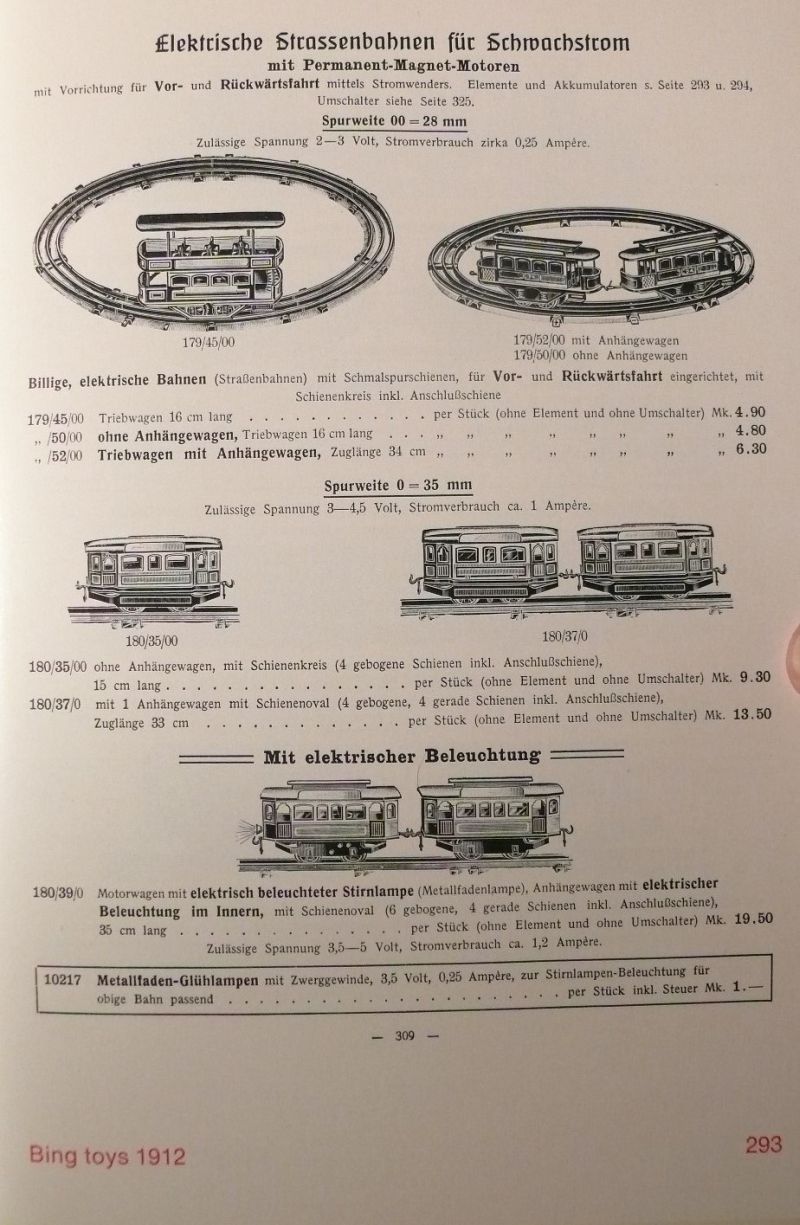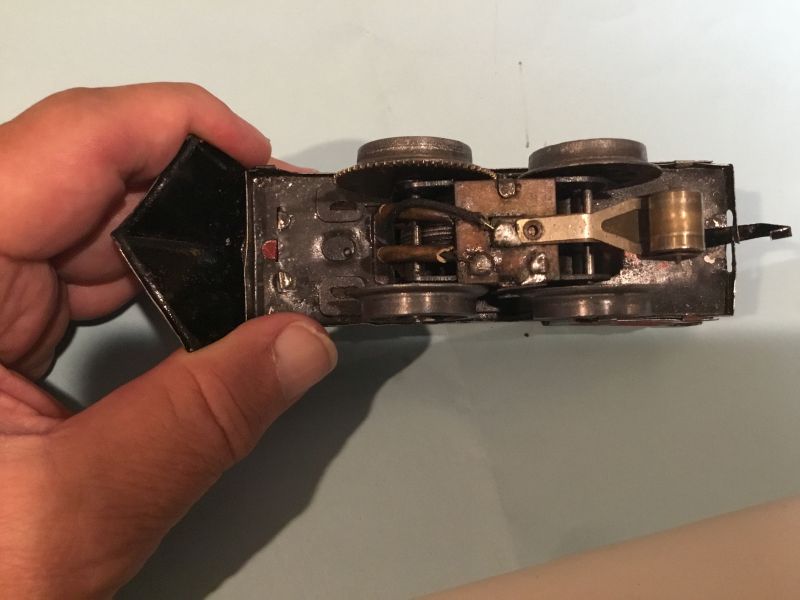Charles,
I found some old track at a flea market and I found your web page
when
I tried to identify it. Its a superelevated 3-rail track. Appears to be
1" between outer rails. Looks like 4 curve tracks make a circle. One of
the curve tracks has two thumbscrew terminals to power the track. The
stamping between the rails looks similar the BW Bing symbol but there
is another symbol next to it. (almost a combination of "D"
and "E" symbols. Between the other two rails it
says "Made in
Bavaria". If you would like photos of this for your web page. I'll be
happy to send them.
|
Hello
Mark:
Thank you very
much for getting in touch with me.
I have not seen
that "combo" symbol before.
It seems to
consist of both my example symbols D and E on page 2 of my
article superimposed
on each other, which would place this track in their logo transition
period around 1923.
The letters in
the top part
of the logo would be GBN (Gebrüder Bing Nûrnberg -
Nürnberg was the toy manufacturing capital of Europe in those
days.)
The "Made in
Bavaria" emphazises the importance of their export market to the UK and
the USA.
The diameter of
that circle would be what - 30 inches?
On
page
8 of my article,
I offer a snapshot summary of Bing, and here it is:
Bing
Bing was a
German firm
(Gebrüder Bing - Brothers Bing) founded in 1865 by Ignaz and
Adolf
Bing in Nürnberg, Germany to make kitchen utensils and toys.
The
Bing firm participated in Märklin's rationalization of track
gauges at the 1891 Leipzig Fair and the consequent boom of the toy
train system concept. Gauge 0 had been introduced by Märklin
in
1895 and by 1900 the earlier larger gauges (II and III for
Märklin
and II, III and IV for Bing [Gauge IV for Bing was equivalent to Gauge
III for Märklin at 75mm. Bing, along with Bassett-Lowke and
Carette, had an in-between gauge at 67mm above Gauge II at 54 mm]) had
given way to Gauges 1 and 0 that came to predominate in the toy train
world in Europe. As for all German manufacturers, the export market was
key to survival and Bing formed trading partnerships with
Ives in the US
and with
Bassett-Lowke in the UK, also being retailed there through Gamage's
catalogue. The Bing firm was, despite its pre-eminence in the Germany
toy industry with over 5,000 employees at the outbreak of WWI, caught
up in the financial turmoil of 1929, and the subsequent advent of the
Nazi regime in 1933 that caused its Jewish owners to flee to the UK.
Bing's assets were subsequently acquired by the competing German firm
of Karl Bub that continued until the outbreak of WWII.
The track in
question is definitely Gauge 0 with a gauge of 1 1/4 inches.
Thank you for
your
invitation to put that symbol up on my website. I was able to save the
image in question from your website. Thank you again for writing to me.
With my best
regards,
Charles
http://www.railwaypages.com/ |
Charles,
Thanks for responding.
I thought this track was really interesting.
It's very narrow, though. I've added a photo to the web page showing a
comparison to O-31. This track gauge appears tobe about 1" and a circle
of four pieces makes a circle about 16.75" in diameter (center rail to
center rail).
If you could add a link to my web page, that would be great.
I've carefully looked at the ties of all 9 pieces that I have and I see
that some ties just have the "BW" logo between one pair of rails and
just "Bavaria" between the other pair.
Mark |
Hello again Mark:
 
I attach two
pictures from my track museum.
The circle (the
three-rail
one) is about 18.5" diameter from centre rail to centre rail, and
because of the BW trademark, would be post 1923. The close-up picture
shows the BW logo, with "Trademark" stamped above the logo, and
"Germany" at the other end of the tie. There were certainly gadzillion
variations on track manufacture.
Yours is the
first "Made in Bavaria" I have seen.
Thank you again
- I have
linked your website as I have credited your contributions, and have
also provided a link to your website under "Links".
Your
observations about and
pictures showing the gauge are a bit of a puzzle, I am not aware that
Bing made anything other than Gauge 0 and Gauge 1. (The track I have
pictured in IMG 6098 and 6101 is 1 1/4" inside rail edges - measured at
the top inside edge, not at the bottom edge of the rail.)
However, the
inter-manufacturer definitions of track widths were a bit
"loosey-goosey" before around 1923 - I have some Märklin and
Karl
Bub tracks that only measure 1 1/8". Your image IMG 2384 seems to come
pretty close to 1 1/8" too. Also I note that your track does not have
any Bing style track connectors - I wonder if this might have been a
"lightweight cheapie" edition, akin to Marx v Lionel?
The 0-31 Lionel
track you
compare it to, judging by the tie design, is later - 1930s and onwards
- higher rail and more robust according to all manufacturers in that
timeframe, and definitely at the 1 1/4" standard by then.
I would place
yours at
between 1920 and 1923. Early on for 0 gauge. North America then still
favoured the Wide Gauge and in Europe Gauge 1 still had some command of the market, in
Germany at least.
Charles |
| I sent 4 pieces of this track
to Charles. |
From:
Charles Cooper
Subject: Re: Bing track
Date: Fri, 24 May 2013 14:36:46 -0400
Hello Mark:
Arrived today -
thank you very much indeed.
Well, I know
you described
it all to me - but this really is remarkable track - and it's not
really 0 gauge at all - it's only 7/8th of an inch between the tops of
the rails, so it's actually S Gauge.
S gauge in the
1920s?? Wow.
I must do a
little more
research on Bing, but this is really quite a find - and I am grateful
that you sent me a whole circle anyway - I'll find room for it - as you
advised, it's not a very large circle anyway - and this is a real
curiosity..
The other thing
that is
interesting is that the track pins are "all three at one end" - for the
export market that would be intended to match with Lionel, and if
anything, Bing was in competition with Lionel.
The real puzzle
though is the gauge - it's so early for S.
Still - "table
top" 00 came in around 1924 - also by Bing.
I have some toy
train history books, and I will do some reading, and get back to you
with anything I can find out..
Thank you again
- what a find. With
my kind regards, CharleBing S-gauge 3 rail train 1s |









 sympatico.ca>
sympatico.ca>
 In July of 2019, I posted about this on the toytrains group on Yahoo!
In July of 2019, I posted about this on the toytrains group on Yahoo!

